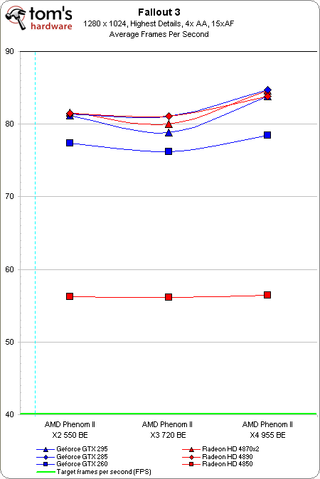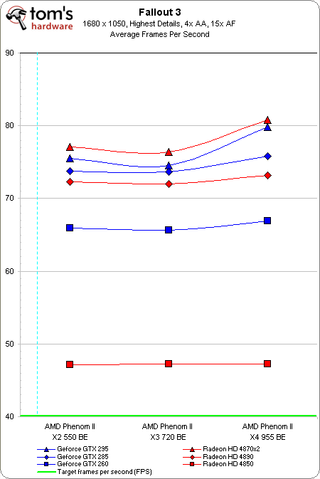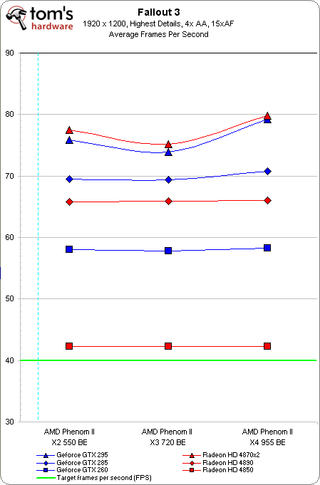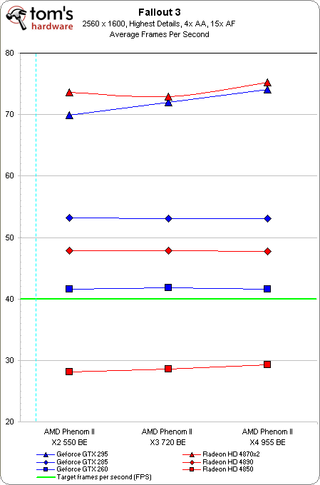Part 2: Building A Balanced Gaming PC
Benchmark Results: Fallout 3
Fallout 3
In Fallout 3, we use FRAPS to benchmark a 60 second run through our “Capital Wasteland” saved game. For smoother combat sequences, we’ll again keep the target at 40 FPS in this action RPG. There was no problem cranking details to maximum, while also enabling 4x AA and 15x AF to further enhance the gaming experience.

Little CPU scaling is seen here, compared to the broader performance range of the Intel processors tested in Part 1. Nevertheless, all of these Phenom II processors basically breeze through Fallout 3. The Radeon HD 4850 is far outclassed by all the other cards, but still manages to deliver playable performance with minimum framerates of 41-43 fps.

The cheapest Phenom II X2 550 BE/Radeon HD 4850 combination is still capable of dishing out playable performance at this highly affordable 20-22” widescreen LCD resolution. Minimum framerates even remain above 30 FPS with each of the three processors.

Again, our cheapest Dragon platform delivers playable performance, even when pushing a 24” LCD resolution. Minimum frame rates now drop to 29-30 FPS, so gamers who demand smoother performance may want to step up to the more powerful GeForce GTX 260.

At 2560x1600, the dual-GPU cards start to pull away from the others. The 512MB Radeon HD 4850 is now reduced to unplayable performance, but the GeForce GTX 260 is able to reach the target and provide 28 minimum FPS with each processor. For just a bit more money, the Radeon HD 4890 manages about six frames higher in both minimum and average fps.
Stay on the Cutting Edge
Join the experts who read Tom's Hardware for the inside track on enthusiast PC tech news — and have for over 25 years. We'll send breaking news and in-depth reviews of CPUs, GPUs, AI, maker hardware and more straight to your inbox.
Current page: Benchmark Results: Fallout 3
Prev Page Benchmark Results: Grand Theft Auto IV Next Page Benchmark Results: Race Driver GRID-
What effect does having a motherboard that unlocks the 4th core on the X2 and X3 have? In power consumption and overall performance? I'm not asking a redo of all the data, just asking for speculation by someone more knowledgeable, if I can get it.Reply
-
Readers, don't use this as your only source of info before buying a PC. The writer left out the Intel i5-750 (which has a price range around $189-209, and outperforms all of those CPUs EXCEPT the i7.) Not only that, but LGA1156 motherboards are typically cheaper than the LGA1336 mother boards. Sure, the i7 has hyper threading, and triple channel memory support, but you're gaming here, not running high end video and 3D programs that would actually make great use of hyper threading. The only benefit I can see, is if you have the extra cash to throw around and you plan on running the applications. I guess a second benefit would be expandability, since you won't be able to upgrade the 1156 chips to Intel's next line of processors, the i9. The i5 can really over clock like a beast with the right motherboard, too.Reply
The writer also left out a great GPU: the Radeon 4870 1GB. Single GPU card, almost perfect for anybody considering running today's games at 22" 1650x1080. Of course, you'd want the 4890 for bigger than that, but still, most of these cards (especially the nVidia ones) are not quite price matched with the performance. A good 4870 can run you $170, and a great 4890 can run you $199. The nVidia "equivalents" (GTX 275, 285, and 260) all run about $260+.
I'm not sure why these two great products were left out (i5 and 4870,) but if there is a good reason, disregard what I said, but honestly, I don't see the good this article is doing without at least including them. -
dragonsprayer The secret to building a balanced gaming by pc, by WarpedSystems.Reply
First, i have been building overclocked only gaming pc's since 2003 with zero failures and 3 year cpu warranty.
#1 cheap cpu - 3.0c northwood - research that far back! CPU = 920 or 750 clocked to 3.8ghz or up too 4.2ghz
#1.5 cpu cooling: in 2004 we used thermalright xp-90, while we still use the thermal right true, we perfer the noctua - research and use the best coolers.
rule 1 of air cooling: dual fans! seal the fans - see photos!
#2 raid, we run dual raid with short stroking - we have been short storking since 2004. Your hard drive arm should move as little as possible a 4 x 1000TB set is 1000GB of raid0 for the c drive. the remaing 3TB is raid 10.
ssd: we run raid5 on hard drive and single ssd as the c drive, the raid 5 is data drive/game drive. This could be a raid0 or raid10.
Video card, you put all your money in the video card! A $2000 computer can have a GTX 295 use the i5 750. A $3000 air cooled system will have 2 video cards.
Power supply = .6 x true max power. this is usually 500 watts to 600 watts of max power. A 750, 850 or 1000 is best. NEVER GO LESS THEN 40% OF AVERAGE! 60% rule allows for a video card upgrade.
Case ...fans, fans and more fans. Anetec 1200 can not be beat for air cooling. All cases are copies of the antec 900. There are many good cases but you want 1 120mm in, 120mm out rear and 1 120 mm blowing on the video card. or 2 80's or bigger
antec 1200 has 2 rear 120mm and 2 front - we pull one section on both the 900 and 1200 and hide wires in the lower cubbie. That means we move the bottom cage up 1 slot, we remove 1 3 slot cage.
check THG links: http://images.google.com/images?hl=en&rlz=1T4GGIH_enUS236US236&um=1&q=warpedsystems+thg&sa=N&start=0&ndsp=18
finally bios tuning - memory and bus speed are critical, too high is bad!!! Too high is bad! fsb 1600 or 400x4 has been the sweet spot for years. Whether your running a G0 6600 at 3.6GHz 1600fsb or QX9600 at 1l multiplier at 4.4ghz 1600fsb works! Above that you run into many many issues. At fsb 1600 ram timmigs are ddr2 = 2.0-2.1v 4-3-4-10, 4-4-4-12, etc with core 2 ddr3 at 1.91v you have 7-7-7 with the i7/i5 you run 1.64v at 8-8-8-20 or 8-7-8-20. you find true 100% stablity with the correct timings and fsb and you do not get odd phase bus speeds.
yes, you can tweek the system to 1800mhz but do the tests and you find in most cases you spent more money to get little performance gains and lost stability -- 97-100% stablity. 100% = zero crashes - never!
temps, video card temps are key. Manually set fan speeds to stay under 75c with 70c the best. Stock temps and high cards run 80-85c even with good systems. You can use really good cooling to reduce that with antec 1200 etc. A 120mm fan does not fit an i7 mobo - we use 92mm fans in the door and hot glue it.
Conclusion, overclock your cpu, remember the difference between an i7 920 and 975 may only be factory setting and both run the same speed! Buy the best video card, use the best cooling case and cpu cooler. If your not using a SSD ....RAID RAID RAID! RUN RAID! IT IS EASY!
good luck, you find you get alienware level performance just as i did in 2003 after a few weeks of bios tuning! -
1898 BlackDays:Reply
Please, if you want to criticise something make sure you've understood it (read in this case) thoroughly. Otherwise you'll look like an idiot.
Anyway, this series is made out of win!
Thank you. -
knightmike This article truly is revolutionary. I have been waiting for an article like this since I began building my own PCs ten years ago. This article coupled with your CPU and GPU hierarchy chart will go a long way towards eliminating CPU/GPU bottlenecks. This article truly is the first of its kind and I hope to see it at least twice a year if not four times a year. Thank you.Reply -
knightmike In your conclusion, you state that a $100 CPU does a far better job than a $100 GPU when it comes to maxing out a low resolution like 1280x1024. Can you elaborate?Reply -
amnotanoobie Hooray! Now this is a good reference on the forums when people ask for bottlenecksReply -
scrumworks How can this take weeks to plan? Perhaps if one works 15mins a day.Reply
Good to see vanilla HD4890 puts up a serious fight for GTX 285. Not that it gets any credit for that.
You should stop using Vista. It's dead already.
Most Popular

